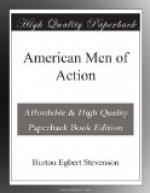Smarting under the sting of this second defeat, Burr sent a note to Hamilton asking if the expression, “a dangerous man,” referred to him politically or personally. Hamilton sent a sneering reply, and expressed himself as willing to abide by the consequences. It was “fighting language between fighting men”—a quarrel which Hamilton had been seeking for five years and which he had done everything in his power to provoke—and Burr promptly sent a challenge. Hamilton as promptly accepted it, named pistols at ten paces as the weapons, and at seven o’clock on the morning of July 11, 1804, the two men faced each other on the heights of Weehawken, overlooking New York bay. Both fired at the word; Burr’s bullet passed through Hamilton’s body; Hamilton’s cut a twig above Burr’s head. Hamilton died next day, and Burr, his political career at an end, buried himself in the West.
Three years later, he was arrested, charged with treason, for attempting to found an independent state within the borders of the Union. He had a wild dream of establishing a great empire to the west of the Mississippi, and had collected arms and men for the expedition, and was on his way down the Mississippi when he was arrested and taken back to Richmond for trial. But his plan could not be proved to be treasonable; indeed, his arrest was due more to the animosity which Jefferson felt toward him, than from any other cause, and, brought to trial a year later, he was acquitted. But his reputation was ruined, there was no hope for him in public life, and his remaining years were spent quietly in the practice of his profession, partly abroad and partly in New York.
It has been too much the habit to picture Burr as a thoroughgoing scoundrel who murdered an innocent man and conspired against his country. As a matter of fact, he did neither. Of the charge of treason he was acquitted, even at a time when public feeling ran high against him, and in the quarrel with Hamilton, it was Hamilton who was at all times the aggressor. Both were brilliant, accomplished and courtly men—even, perhaps, men of genius—but Fate spread a net for their feet, blindly they stumbled into it, and, too proud to retrace their steps, pushed on to the tragic end.
The presiding judge at Burr’s trial, not the least of whose achievements was the holding level of the scales of justice on that memorable occasion, was the last of that great school of statesmen who had fought for their country’s independence, and who had seen the states united under a common Constitution. John Marshall lived well into the nineteenth century, and his great work was to interpret that Constitution to the country, to give it the meaning which it has for us to-day. Marshall was a Virginian, was just of age at the outbreak of the Revolution, and served in the American army for five years, enlisting as a private and rising to the rank of captain. At the close of the war, he studied law, gained a prominent place in the politics of his state, drew the attention of Washington by his unusual ability, and in 1800 was appointed by him secretary of state. A year later he was made chief justice of the Supreme Court—an appointment little less than inspired in its wisdom.




